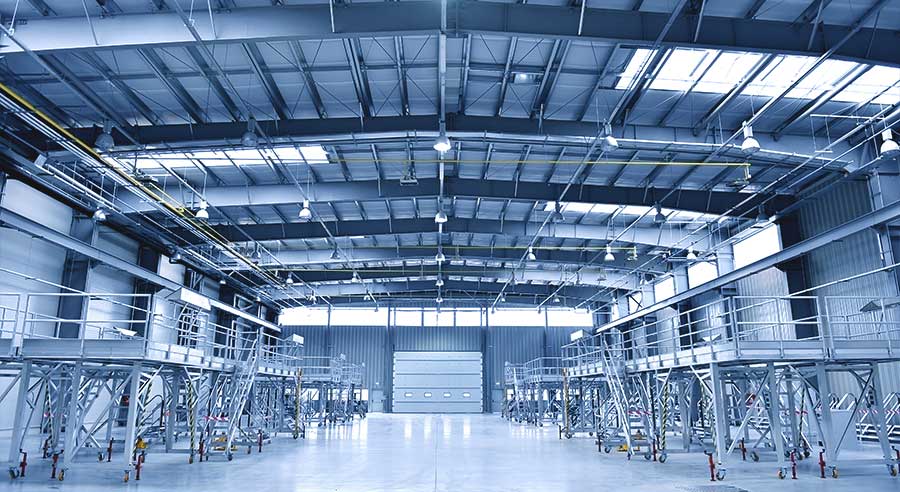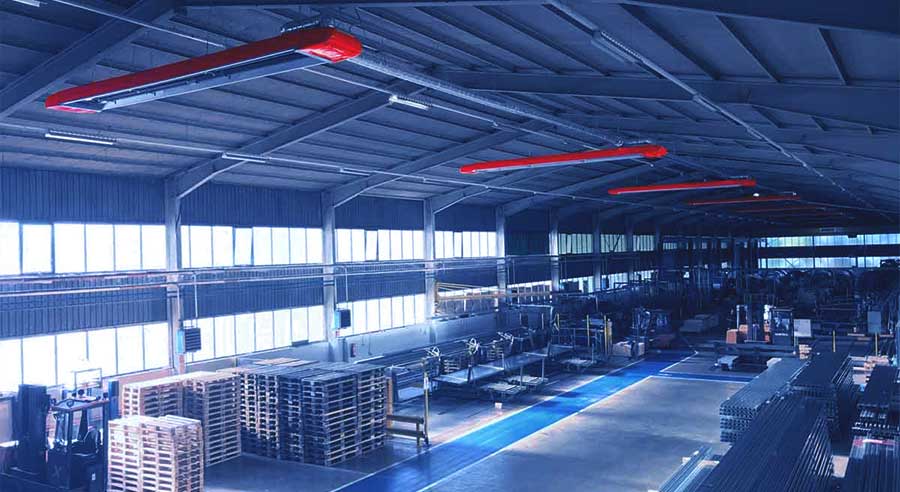How to find the optimal hall heating
Do you want to get the most out of your new hall heating system, save energy costs and be prepared for environmental legislation of the future? Then it is advisable to consider some tips before buying. You can find out which ones in this article.
First of all, be aware that industrial and commercial buildings have different heating requirements than homes or offices. Sounds trivial? But it is not. Because, in fact, many planners still make the mistake of applying a heating strategy similar to that used for multi-story buildings. The problem: Warm air rises to the top. This is not relevant for low ceiling heights, such as in offices or apartments. In halls, on the other hand, the warm air collects quasi uselessly at a great height under the hall roof.
Until it is pleasantly warm on the ground, operators have to channel a lot of heating energy into the hall and use systems that direct air flows back down. Basically a waste of money, because heat is usually only required in large halls at a person height of around two meters, but not at higher elevations. Therefore, as a rule, it is enough to heat 20 percent of the volume of the room. Already then employees have it pleasantly warm and can develop full productivity.
Find the right technology for your hall heating
Now the question is what technology to consider to specifically heat the 20 percent or so of your hall. If you look around the market, you will notice: There are centralized and decentralized heating systems. Central systems include such things as industrial radiant floor heating, centrally supplied water-based air heaters, and hot water radiant ceiling panels. They work with a central power generator and a piping system that transports hot water to the desired location.
On the other hand, decentralized heating systems include infrared heaters that can be mounted under the ceiling. They are gas-powered and work with electromagnetic waves. As soon as the waves hit a solid body, such as a person or the room frame, the energy is converted into heat. The highlight: Infrared radiators do not heat the air! In this way, only the occupied and usage area is heated.
At the same time, hall operators enjoy flexibility. They specifically divide the hall into different heating zones with several infrared radiators - and provide more heat to employees in order picking, for example, than to colleagues in production, where machines already provide sufficient basic heat. A flexibility that strengthens employee satisfaction. Even if the hall is converted, it is easier to adapt the system with these decentralized solutions compared to the centralized system.
Another advantage of infrared technology: it is responsive. Operators switch the heating on and off in a similar way to the lights. Since the energy does not take a detour via the air, heat is available virtually at the push of a button. And you don't even need to manually turn on and off in the automation age. This task is performed by intelligent control technology, which adapts the heating power to the changing conditions. Users thus reduce energy costs by up to 70 percent, so that the investment in the heating system pays for itself in a short time.
Get an overview of the requirements of your hall
In order for hall heaters to develop their full potential, they should be adapted to your hall like a tailor-made suit. However, this adaptation by an external service provider will only succeed if you have a clear picture of your hall building, hall use and your heating requirements in advance. Be particularly oriented to the factors that could have an impact on the temperature. These questions can help you do that:
- What are the dimensions of your hall?
- What is the condition of the building?
- How is the hall used?
- Are there different areas and times of use?
- What about gate opening hours?
- How has heating been done so far - is there consumption data?
- What goals and requirements should the new heating system meet?
The answers to these questions provide a foundation on which your heating partner can build.
Think through different energy sources for your hall heating system
In times of climate change, the German government's targets are ambitious: Germany is to be climate-neutral by 2045 at the latest. Accordingly, industry is making efforts to reduce CO2 emissions. Many companies are saying goodbye to heating oil, which will be banned for new buildings from 2026 anyway, and are instead focusing on renewable energies and technologies such as solar thermal energy or electric heat pumps.
If you decide to go this route, however, you should be aware that you are committing to a central heating system. And for this you need a hydraulic distribution system. In addition, such a system is often associated with two to four times higher investment costs and is comparatively inert, so that in many cases the heat supply cannot be adapted quickly enough to dynamic requirements.
Infrared radiators work with natural gas. But compared to other fossil fuels, this gas is environmentally friendly as thelowest CO2 among the classic fuels, as it has the lowest primary energy factor of all. In addition, natural gas is becoming increasingly green due to the upcoming feed-in of regeneratively produced hydrogen (power-to-gas technology) and is considered one of the most sustainable energy sources in Germany, especially in conjunction with the excellently developed gas network.
Now you may be wondering: The new Building Energy Act (GEG) stipulates that in the future I may only heat with renewable energies. Isn't an infrared heater prohibited there? No! According to the GEG, from a hall height of more than four meters you are no longer bound to regenerative energy sources. While central heating systems are required to use renewable energy to meet GEG specifications, the most efficient infrared indoor heating technology allows them to be implemented using natural gas. So you don't have to worry about compliance.
Take a close look at hall heating suppliers
To ensure that you find an efficient and future-proof hall heating system, you should check the competence of suppliers in advance. The following questions are suitable for orientation:
- What references does the provider have?
- Is there a nationwide service (if you have or want to set up multiple locations).
- Can you trust that you will still receive spare parts and service in 15 years?
- Does the provider have a development department that is innovative and develops products according to modern standards?
- Do the employees appear competent?
- Is the system flexible? Can it be adapted to changes in the law and conversions without much trouble?
It is also advisable to focus not only on the price of the hall heating system, but also on the total cost of ownership (TCO) - i.e. the operating costs over the entire life cycle. Only with this value can you calculate whether it is a worthwhile investment.
HALL HEATING: 6 HEATING SYSTEMS AT A GLANCE
Warm air, panel heating or rather infrared? A wide variety of heating systems are available for heating halls. Depending on the requirements, one is more suitable, the other less. This article will give you an initial overview of the six most relevant systems for industrial and commercial halls and how they work.
Getting started - the difference between centralized and decentralized systems
Systems for heating halls are divided into centralized and decentralized systems. Centralized systems require a separate boiler room where heat is generated. This heat is then conducted to the heating devices, where it heats the heating medium conducted in it, which in turn provides heat for heating. This process is also known as "indirect heating." However, part of the heat is already lost through the transport. Decentralized systems, on the other hand, use the primary energy directly in the usable space or the heating unit itself, which first generates the heat where the employees need it. They do not require a separate boiler room, are more flexible and can be used more quickly.
Warm air heating of halls: You have these options
The basic principle behind warm air heating systems is very simple and quickly explained: a fan directs warm air into a room and heats it in this way. If you want to rely on warm air to heat halls, you have two options:
DECENTRALIZED HEAT SUPPLY VIA WARM AIR GENERATORS
In the case of direct-fired warm air generators, the burner generates the heat directly in a decentralized manner. By means of a heat exchanger, air drawn in on the secondary side is then heated and blown into the hall.
When heating halls with the help of warm air generators, room air-dependent and room air-independent modes of operation can be used. This means that the unit either draws in fresh air or heats the air from the hall itself. The latter is particularly practical. After all, since warm air is known to rise, the air in the working or floor area tends to be colder. Room-air-dependent warm-air heaters feed precisely this cool air back into the warm-air generator, thus providing a supply. Room-air-independent units, on the other hand, often additionally use the heat of the exhaust duct to heat the air supplied from outside.
CENTRAL HEATING OF HALLS WITH AN AIR HEATER
Indirectly heated air heaters, also called air heaters, do not heat the air themselves. Rather, a separate boiler or central heating system is connected here, which heats the heat exchanger externally. The air heater also draws in air and then passes it over the heat exchanger, which heats it. Then the warm air can be blown into the hall or distributed through air ducts. If you want to use an air heater to heat halls, you should again consider convection and plan accordingly for warm air recirculation or ceiling fans.
Surface heating systems for heating halls
Basically, you can install panel heating in the floor, ceiling or walls. Underfloor heating is probably the most common, but the system behind it is basically the same. For underfloor heating, thin pipes are laid in the floor in a snake-like pattern covering the entire area when the hall is built. Underfloor heating can also be installed later in an additional screed layer.
To heat halls, an externally heated heating medium (e.g. water) is passed through these pipes. The heat generated in this way can be felt directly in the floor and is only slowly released into the room, but remains there for a while even if the heating is switched off for a short time.
Please note with this heating system that too deep anchoring of shelves or machines can damage the heating hoses.
Not to forget: The radiant heating systems
When heating halls via radiant heat, a distinction is made between light and dark radiators. In addition, there are the ceiling radiant panels.
RADIANT CEILING PANELS
Also known as "hot water ceiling radiant panel," this system uses pipes welded to a metal plate directly under the ceiling. Similar to underfloor heating, hot water heated by an external heat generator flows through these tubes, transferring heat to the entire structure. A radiant panel then conducts the heat down into the room, where it raises the surface temperatures of all surfaces.
You should place an insulation layer between the ceiling and the radiant ceiling panel to reduce heat loss upward. If you want to use radiant ceiling panels to heat halls, you should also plan for a large heating area of about 15-20% of the ceiling area.
DARK RADIATORS FOR EFFICIENT HEATING OF HALLS
Dark radiators, also known as black radiators, are a variant of infrared radiant heating systems. In this case, halls are heated decentrally by individual units that use a burner to produce a long flame in a radiant tube. The energy source is usually natural or liquid gas, but biogas and hydrogen also have potential for the future.
Reflectors on the radiant tube direct the heat generated in the form of infrared radiation into the areas to be heated. There, this only provides heat when it hits the enclosure and surfaces of objects or people - similar to the sun. The decisive advantage of radiant heating of this type is therefore that no warm air physically rises under the ceiling and must be returned.
LIGHT RADIATORS: HEAT GENERATION VIA CERAMICS
Light radiators work in a similar way to dark radiators. A gas-air mixture is burned on ceramic plates, generating heat and emitting infrared radiation. Here, too, reflectors direct the rays specifically into the working area. The fundamental difference, however, is in the combustion process. In the case of bright radiators, combustion takes place openly - and thus the exhaust gases initially remain in the room. Indirect discharge of the exhaust gases is therefore necessary. Anyone who relies on bright radiator systems to heat halls must therefore ensure adequate ventilation.
What is particularly worthwhile for heating halls?
Which heating system is the right choice for you depends entirely on your usage profile and your economic requirements. For room heights of 4 meters and more, however, infrared dark radiators are recommended at this point, as they are particularly well designed for the physical characteristics of halls and are characterized by comparatively low investment costs with high efficiency, flexibility and operational reliability. Let us talk about it in a personal meeting - or use our configurator to find out which heating system is best suited for your object!
Heating with infrared radiant heaters: These facts you should know!
A new heating system for your company's production is a decision that needs to be carefully considered. After all, it's not just about warm halls. There is much more to it than that:
- Saving heating costs sensibly
- Increase energy efficiency
- Create thermal comfort at the workplace
- Ensure operational flexibility and
- Meet environmental and legal requirements
Are you thinking about whether infrared radiant heaters are the right choice? Then these following facts should make your decision easier!
How infrared dark radiators work
Before we get into the hard facts, let's first clarify two basic questions and clear up common misconceptions. What are radiant heaters and what distinguishes infrared dark radiators from bright radiators?
Many answers you find on the Internet about this are not very enlightening or are simply nonsense. What is correct is that both light and dark radiators are radiant heaters, since in their case heat transfer is almost exclusively by infrared radiation. For this purpose, natural gas or liquid gas are usually used as energy sources. However, biogas or hydrogen, e.g. from regenerative sources, also have great potential for the future.
Dark radiators use closed combustion in a pipe system. Light radiators work with open combustion. The main difference is therefore in the way the combustion exhaust gases are handled: With light emitters, these initially remain in the hall atmosphere. For this reason, sufficient ventilation must be provided for these systems. In the case of infrared dark radiators, the exhaust air is discharged to the outside via an exhaust system - without polluting the hall atmosphere. This is why the use of dark radiators is the preferred choice in most applications today.
In both systems, the heat generated is directed as infrared radiation into the areas to be heated. Similar to solar radiation, heat is generated as soon as the infrared rays hit bodies or objects. Thus, among other things, the hall floor, the room frame and the people in the working area are heated directly.
The special thing about it: Dark radiators heat by their infrared radiation thus no ambient air, but only directly that, which is to be really heated. Thus there is also practically no warm air, which rises physically conditioned under the hall roof, instead of remaining in the work area. This is precisely the decisive advantage of infrared radiators in terms of efficiency.
No hot air - no air movement
You can't make an omelet without breaking eggs. Or a lot of dust is created. This dust is stirred up by conventional hot-air heating systems often used in halls. This is a problem in many companies, but it can be easily counteracted with infrared dark radiators. These heat no air and therefore no draught can arise or dust can be stirred up. For your employees and visitors, this means a healthy, dust- and draft-free working atmosphere.
Infrared dark radiators heat particularly efficiently
Let's stay briefly with warm air heaters, which are commonly used in industrial and commercial halls. Simple physics quickly makes it clear that these are not particularly efficient for heating large halls: After all, the heated air rises straight up. To ensure that it is warm not only under the roof but also in the actual usable zone of the hall, the air must be continuously reheated. If the hall door is constantly open or the hall is outdated and insufficiently insulated, this results in an enormous waste of energy and money.
Infrared dark radiators, on the other hand, only heat the objects and bodies they hit - as already described. And if no warm air is produced, no warm air can escape. In addition, the operation of dark radiators can be flexibly adapted to a wide variety of situations that arise when working in halls by means of an appropriately intelligent control system:
- Door opening times
- Working and shift times
- Different usable zones of the hall, in which different amounts of heat are also required
Infrared radiant heaters are therefore particularly efficient. Expressed in clear figures: they consume up to 70 % less energy than conventional systems. Modern infrared radiant heaters are therefore currently the most efficient heating systems for industrial and commercial buildings. And this means that you not only recoup the initial costs quickly, but also do something good for the environment.
No need to worry about GEG & Co.: Even high efficiency requirements can be safely met by modern infrared dark radiators.
Speaking of environmental protection: Those who have not taken care of efficient heating systems and other energy-saving measures in their halls in recent years are increasingly being forced into action. In order to achieve the goals of the Climate Protection Plan 2050, the legislator is calling for the economical use of energy in various ways. Important here for Germany, for example, are
- the GEG - Building Energy Act (since 01.11.2020) and
- the CO2 tax (since 01.01.2021).
And as far as energy management certifications are concerned: Anyone who wants to fulfill the audits according to the then valid stricter DIN EN ISO 50001 (2018) after mid-2021 must also fulfill increasing efficiency requirements here.
The GEG, which summarizes the previous complex energy saving laws, demands among other things the increased use of regenerative energy sources. The fact that infrared dark radiators run on gas seems to contradict this. Or?
No, on the contrary. This widespread misconception arose due to misleading wording in the old legislation and still causes some uncertainty. But the fact is: modern infrared dark radiators have always been used in compliance with the law due to their high energy efficiency - in new buildings as well as in renovations. In the GEG, this high efficiency is now increasingly recognized by exempting decentrally heated halls with room heights of more than four meters from the obligation to use regenerative energies. In addition, gas as an energy source not only has a good primary energy factor. Gas is the technology of the future with great potential as soon as power-to-gas, i.e. the production of hydrogen, becomes available in large-scale industrial processes. So gas-fired infrared dark radiators will remain the gold standard for energy-efficient heating of hall buildings in the future. And that pays off in the truest sense of the word.
Dark radiators are an investment that pays off. Right from the start.
One mistake that is made particularly frequently when planning hall heating systems is a failure to look at the big picture. The new devices should be as inexpensive as possible in terms of investment - and this pays off in the long run if the consumption costs are disregarded. After all, a hall heating system consumes x times its investment costs over its life cycle. It is therefore important to focus on life cycle costs. The keyword here is: low TCO - Total Costs of Ownership. You can save (or even spend!) a lot of money at the wrong end without it being really effective in the end.
So which heating system is worth it - even in the long run? The answer is: the heater that best fits your usage profile and meets your economic requirements. Infrared dark radiators are characterized by low investment costs compared to many other systems. This is confirmed by the results of a study we conducted together with the Technical University of Kaiserslautern. Investment costs for the use of regenerative energies such as a heat pump in conjunction with underfloor heating or a wood pellet stove coupled with radiant ceiling panels are between a factor of 1, 8 to 4.0 - on average a factor of 3.0! - higher than for a dark radiator system with residual heat utilization.
Regenerative energies are all well and good in residential buildings, but in halls they clearly lag behind the specially developed dark radiators. This is because regenerative energies differ functionally from classical energy sources in one important point and that is the low temperature level. This low temperature level always ties renewable energies to hydraulic solutions, at the end of which is warm air. And warm air as heat transfer in high spaces is dysfunctional, as we have already seen. Who benefits from generating a lot of renewable energy for a lot of money, which then does not develop the necessary heat at the workplace? Halls have completely different conditions due to the significantly higher rooms.
In addition, infrared dark radiators score - as already mentioned - with high efficiency and low annual energy requirements. The investment costs are amortized after just a few years. A dark radiator therefore clearly pays for itself in most halls.
Achieve personal and energy goals with dark radiators
No matter whether your hall is four, ten or more meters high: dark radiators are a sustainable investment that will not only increase the satisfaction and productivity of your employees, but will also help you meet energy policy targets thanks to their high efficiency. Please feel free to inform yourself here. If you would like to talk about specific plans right now, let's have a conversation and discuss the different requirements of your industry.






